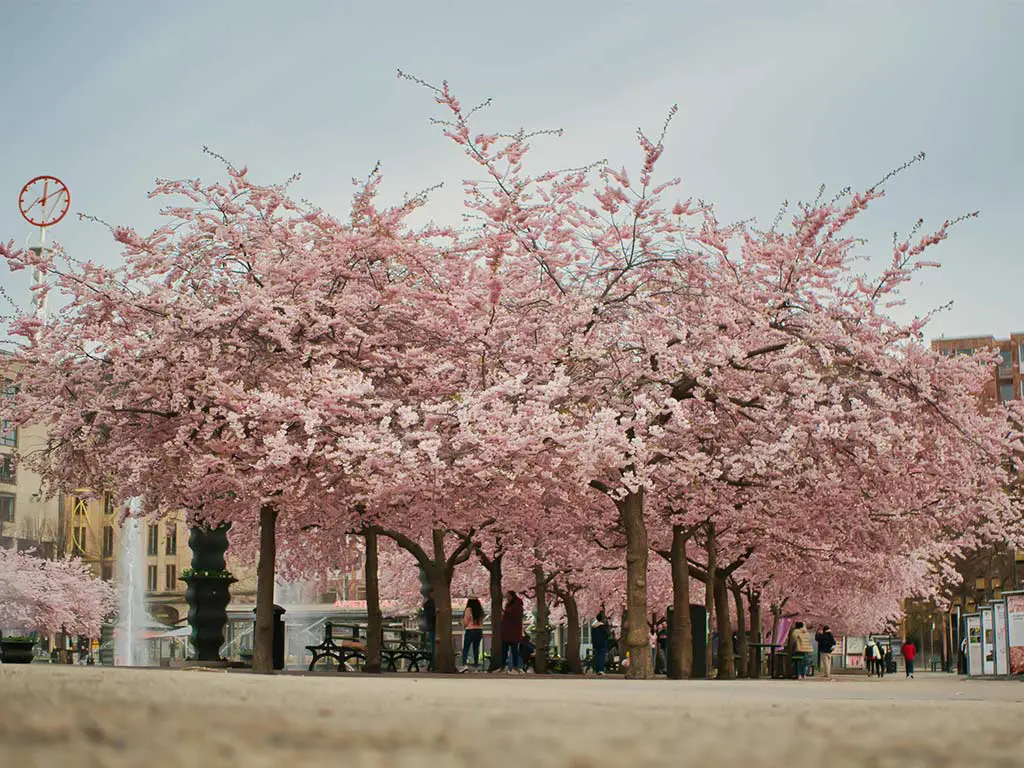When you think of Washington DC, one iconic image that comes to mind is the breathtaking sight of cherry blossoms in full bloom.
The history behind the cherry blossom trees in Washington DC is a tale of friendship, cultural exchange, and natural beauty.
These delicate pink and white flowers hold a special place in the hearts of locals and visitors alike, symbolizing the enduring bond between the United States and Japan.
Every spring, the National Cherry Blossom Festival in Washington DC celebrates the gift of 3,000 cherry trees from Japan to the United States in 1912.
This annual event attracts millions of people from around the world to witness the stunning display of blossoms along the Tidal Basin.
The history of the cherry blossom trees and the festival itself is a testament to the enduring spirit of friendship and goodwill between nations.
So, immerse yourself in the enchanting history of the cherry blossoms in Washington DC and discover the beauty that has captivated generations.
Origins of Cherry Blossoms in Washington DC

The origins of cherry blossoms in Washington, D.C., can be traced back to a gesture of friendship between the United States and Japan:
The Role of Eliza Scidmore
Eliza Scidmore, a prominent National Geographic Society writer, played a pivotal role in bringing cherry blossoms to Washington DC.
Scidmore was captivated by the beauty of these trees during her travels to Japan, sparking her vision to adorn the capital with these mesmerizing blooms.
Although her initial proposal in the 1880s was met with resistance, she persisted in advocating for the introduction of cherry blossom trees to enhance the aesthetic appeal of DC.
The Gift from Japan
In 1912, Japan gifted 3,000 cherry blossom trees to Washington DC as a symbol of friendship and goodwill between the two nations.
This generous gesture marked a significant historical moment, solidifying the bond between Japan and the United States.
The cherry blossoms were planted near the Tidal Basin, creating a breathtaking display that has since become an iconic symbol of spring in the nation’s capital.
The cherry blossom trees were carefully selected and shipped to Washington DC, where they were planted by First Lady Helen Taft and the Viscountess Chinda, wife of the Japanese ambassador. This event sparked an annual tradition of celebrating the National Cherry Blossom Festival.
History of the cherry trees

The history of the cherry trees in Washington, D.C., is a story of friendship, diplomacy, and natural beauty:
Early Initiatives
Eliza Scidmore, inspired by the beauty of cherry blossoms in Japan, initiated the effort to introduce cherry trees to Washington DC in 1909.
Despite initial challenges, her determination led to the donation of 3,000 cherry blossom trees from Japan in 1912, symbolizing the friendship between the two nations.
These trees were planted near the Tidal Basin, creating a spectacular display that has since become an iconic symbol of spring in the capital.
National Annual Event
The National Cherry Blossom Festival, celebrating the gift of cherry trees, has become an annual event attracting millions of visitors each year.
This festival honors the enduring bond between the United States and Japan. The festival features various activities, including art exhibitions, dance performances, live music, and fashion shows. It serves as a reminder of the rich history and significance of the cherry trees in Washington DC.
Evolution of the Cherry Blossom Festival

The National Cherry Blossom Festival in Washington, D.C., has evolved significantly since its inception in 1912, growing into a major cultural celebration and tourist attraction:
Early Celebrations
In the early years following the planting of the cherry blossom trees near the Tidal Basin in Washington DC, the sight of the blossoms quickly captured the hearts of the public.
The trees, originally donated by Japan in 1912, soon became a beloved symbol of spring in the city. The annual blooming of the cherry blossoms marked a time of celebration and renewal, drawing visitors from near and far to witness this natural spectacle.
Over time, the cherry blossoms evolved from a simple gift into a cherished tradition that symbolizes the enduring bond between the United States and Japan.
Modern Developments
As decades passed, the National Cherry Blossom Festival underwent significant developments to become the grand celebration it is today.
From its humble beginnings honoring the initial gift of trees, the festival has grown to encompass a diverse range of activities and events.
Modern iterations of the festival now feature cultural performances, art displays, live music, and other forms of entertainment that showcase the rich heritage of both nations.
The festival has become a symbolic representation of friendship, cultural exchange, and the beauty of nature, drawing millions of visitors each year to partake in the festivities.
Cultural Significance and Diplomacy

International Friendships
The cherry blossom trees gifted by Japan to the United States hold great importance in fostering international friendships.
The donation of 3,000 cherry blossom trees from Japan in 1912 symbolized a gesture of goodwill and friendship between the two nations, representing a lasting bond that has endured over the years.
This act of generosity served as a diplomatic exchange, signifying the positive relationship between Japan and the United States.
Symbolism in Cherry Blossoms
Cherry blossoms have deep symbolism in Japanese culture, representing the transient nature of life and the beauty of existence. In Japan, the cherry blossom, or sakura, is a symbol of renewal, hope, and new beginnings.
The cherry blossom’s brief blooming period serves as a reminder of life’s fleeting nature, encouraging people to appreciate the present moment.
This symbolism transcends borders and has been embraced in Washington DC, where the cherry blossoms have become a powerful symbol of spring, beauty, and cultural exchange between nations.
Conservation and Controversies
The conservation of the cherry trees in Washington, D.C., has been a priority to preserve their beauty and historical significance.
However, there have also been controversies surrounding their care and management:
Preservation Efforts
When it comes to preserving the iconic cherry blossom trees in Washington DC, significant efforts have been made over the years to protect and maintain these beloved symbols of friendship between the United States and Japan.
From planting new trees to implementing conservation strategies, various initiatives have been undertaken to ensure the longevity of these beautiful blossoms.
Ongoing collaboration between the National Park Service and local organizations plays a crucial role in safeguarding the cherry blossom trees.
Regular maintenance, disease prevention, and public awareness campaigns are key components of these preservation efforts.
Historical Challenges
Despite the enduring popularity and cultural significance of the cherry blossom trees, there have been challenges throughout history that have threatened their existence.
From acts of vandalism during times of conflict to natural threats like beavers damaging the trees, the preservation of these cherished symbols has not been without its obstacles.
However, through dedicated conservation efforts and community support, these challenges have been met with resilience, ensuring that the beauty and symbolism of the cherry blossoms continue to thrive in Washington DC.
Frequently Asked Questions
What is the history of the cherry blossoms in DC?
Cherry blossoms, known as Sakura in Japan, were first brought to DC by Japan in 1912, symbolizing friendship between the US and Japan.
Do the cherry trees in DC produce cherries?
Yes, they produce cherries, but they are small, mostly pit, and not the same as commercial cherries.
Which first lady brought cherry blossoms to DC?
Helen Taft planted the first two cherry trees in DC in 1912, near the Martin Luther King, Jr. Memorial.
What is the story of cherry blossoms?
Cherry blossoms were originally used to predict harvests and now symbolize impermanence, renewal, and hope in Japanese culture.
Conclusion
The cherry blossom trees in Washington DC stand as a symbol of enduring friendship between nations and a celebration of nature’s beauty.
With roots tracing back to the early 20th century, these iconic trees have become an integral part of the city’s cultural landscape.
The National Cherry Blossom Festival continues to draw crowds from around the world, showcasing a blend of art, culture, and tradition.
As you witness the delicate pink blooms each spring, remember the rich history and significance behind these trees.
Through preservation efforts and community support, the cherry blossoms will continue to enchant visitors for generations to come.
Explore the history, embrace the beauty, and immerse yourself in the timeless allure of Washington DC’s cherry blossoms.




Allison Brice